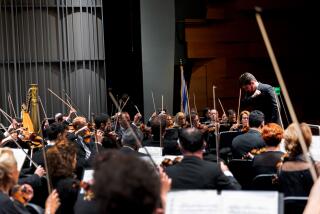ANDRES SEGOVIA, 1893-1987
- Share via
The last time I heard Andres Segovia play a recital was in 1976. He was only 83 then.
I really didn’t want to hear him after that. I wanted to remember him in his prime, or at least close to it. That may have been a mistake.
Segovia was a magician. He could make the little guitar sound like a big orchestra. He could make the huge Dorothy Chandler Pavilion seem like an intimate salon.
As he endured the precarious transition from musician to legend, he retained the ability to transfix adoring, predominantly youthful audiences. The aficionados who afforded him reverence, awe and push-button standing ovations at his final concerts could have been his grandchildren, even his great-grandchildren.
Even when his aging fingers began to revolt at the demands dictated by his ever-inquiring brain, he remained a compelling artist. Broadcasts and pirate tapes proved that. The missed notes were trifling technicalities.
He was wise enough, moreover, to capitalize on certain advantages of maturity. When there were losses in flamboyance, there were gains in mellowness.
Ten years ago--and probably last month, too--Segovia could still give object lessons in style, in elegance of phrasing and subtlety of inflection.
He wasn’t like certain other senior citizens in the irrational world of music. He exulted in the communicative power of serenity, sustaining tension while exuding an aura of relaxation. He didn’t care for obligatory rituals, didn’t do anything, it seemed, by rote.
Great music sounded great when he played it. We could count on that. But Segovia also made trivial music sound great. He did for J.S. Bach what he did for V. Ascencio.
He also could offer object lessons in the organic affect of a well-turned embellishment and in the vitalizing function of a tender rubato.
Writing about his Music Center recital back in 1976, I cautiously noted some moments when unsteadiness threatened to ruffle the composure of the music, if not that of the musician. A few days later, the mail brought a letter from Av. Concha Espina in Madrid. I opened the envelope rather nervously.
“I know that in your Country it is not customary for an Artist to thank his Critic for a review, and I usually comply with this principle,” wrote the courtly Segovia, with obvious affection for capital letters. “(But) I was very touched by the warmth shown in the expression of your thoughts about the guitar and myself.”
The critic was touched in turn.
Segovia went on to request a copy of the photo that had accompanied the review.
Even at 83, he took nothing for granted.
More to Read
The biggest entertainment stories
Get our big stories about Hollywood, film, television, music, arts, culture and more right in your inbox as soon as they publish.
You may occasionally receive promotional content from the Los Angeles Times.










